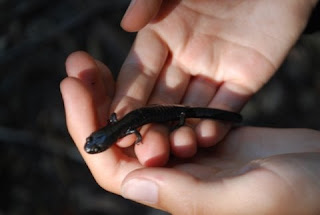Watersheds are often defined using bathtub terminology: the rim of the tub represents the highest ridges of an area, and the water flowing down its sides emblematic of waterways following gravity’s mandate and eventually reaching the “drain.” But this analogy can only go so far. If you truly want to learn about a watershed, go out and see one. And if you want to become a steward of your watershed, spend time exploring the one that you call home.
To introduce students to the Pajaro Watershed, we began in a wild area near the top of Eureka Canyon called Grizzly Flat. Outside temperatures dipped under the cooling influence of riparian vegetation and rushing water as our vehicles climbed the narrow road running parallel to Corralitos Creek. Then we walked a forested trail that led to the small, cool stream. After some exploring, students came across local residents, including newts, salamanders, and frogs. Stretching a kick net across the water revealed an abundance of aquatic invertebrates, including stoneflies, mayflies, caddis flies, and worms. Water quality tests informed us that this stream was cold, oxygen rich, and low in nitrates and phosphates—in other words, ideal for supporting a wide diversity of aquatic life.



We chose to begin our program in this beautiful location
partly because it fits nicely into a logical framework, but mostly because we
hope to combat the eco-fatigue that plagues so many students. While an
important component of Farms to Fishes
is to investigate the threats watersheds face, we wanted to ensure that
students first establish a positive connection with their environment before
diving into what’s wrong with the picture. Many young people have had limited
opportunity to develop a relationship with the natural world, and we believe
that they need a concrete sense of what they are trying to save in order to
build a strong foundation on which to build a conservation ethic.
 Farms to Fishes: Understanding Watershed Health through Food and Community is a project of Wild Farm Alliance made possible by a grant from NOAA's Bay-Watershed Education and Training (or B-WET) Program. Through collaboration with a variety of educational partners, we endeavored to provide local students with "meaningful watershed experiences" over the course of the 2010/2011 school year (i.e. getting kids outside and doing our best to make sure they learn a lot and have a great time.) The goal was to educate students about a frequently skipped yet significant topic: the role of agriculture and citizen activity in the health of watersheds and marine ecosystems.
Farms to Fishes: Understanding Watershed Health through Food and Community is a project of Wild Farm Alliance made possible by a grant from NOAA's Bay-Watershed Education and Training (or B-WET) Program. Through collaboration with a variety of educational partners, we endeavored to provide local students with "meaningful watershed experiences" over the course of the 2010/2011 school year (i.e. getting kids outside and doing our best to make sure they learn a lot and have a great time.) The goal was to educate students about a frequently skipped yet significant topic: the role of agriculture and citizen activity in the health of watersheds and marine ecosystems. Classroom sessions and field trips that focused on agriculture, natural areas, and the impact of urban activities on ocean health helped students examine the connections between food grown on the land and the fish we eat. These tangible examples illustrate why protecting watersheds and conserving marine resources matters. Our hope is that an increasing familiarity with natural places will leave a lasting impact on the upcoming generation and the adults directly involved in their education, inspiring them to care for the environment in which they live.
Classroom sessions and field trips that focused on agriculture, natural areas, and the impact of urban activities on ocean health helped students examine the connections between food grown on the land and the fish we eat. These tangible examples illustrate why protecting watersheds and conserving marine resources matters. Our hope is that an increasing familiarity with natural places will leave a lasting impact on the upcoming generation and the adults directly involved in their education, inspiring them to care for the environment in which they live. 




















